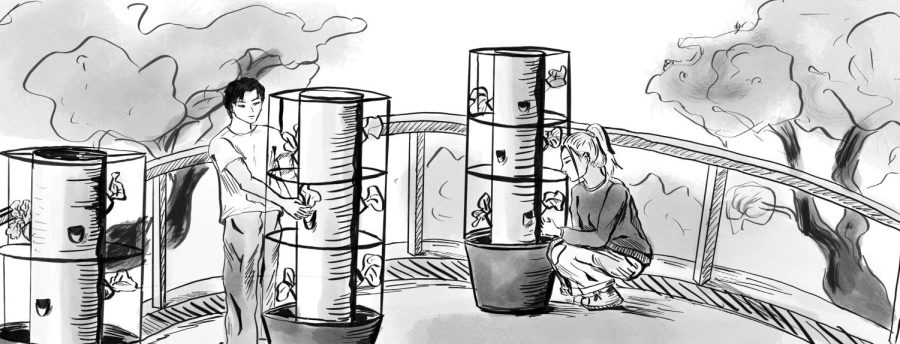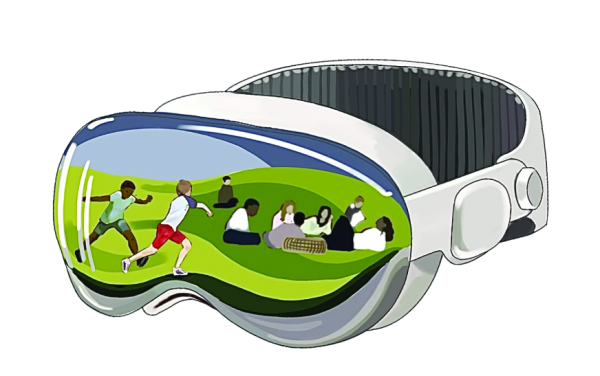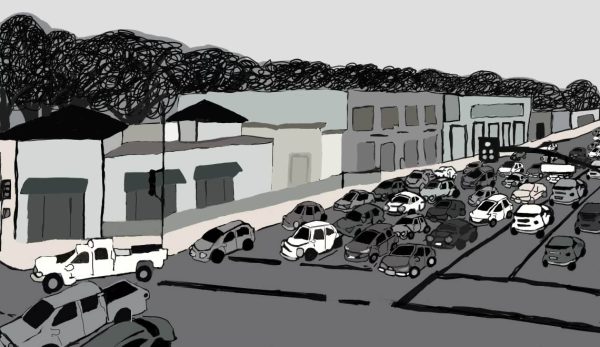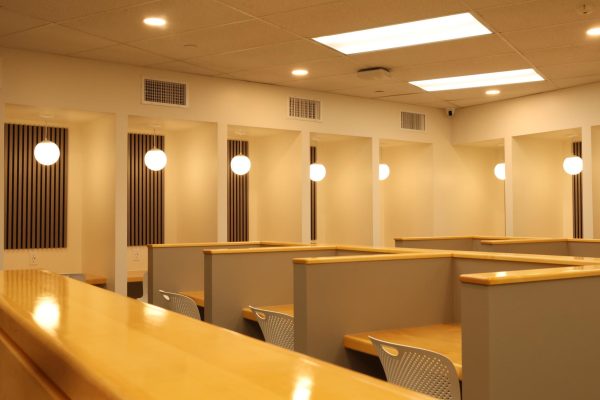Reducing our environmental impact
Students tend to the hydroponic plant towers.
March 22, 2023
The upper school campus has a sustainability problem, and it’s nothing new either. We all know about our plastic-packaged food in the cafeteria, excessive food waste problem and extravagant energy use — and the list goes on. Contrast this with the new River Park campus, whose team has taken great care to bring environmental initiatives — like stormwater capture systems, native landscaping and solar panels — into every aspect of development. When looking at these two campuses, the reason for the disparity between them seems obvious: everything in River Park is new while the buildings at our Coldwater location are mostly remnants of the 20th century. Any renovations at the upper school campus are extremely costly and tricky to pull off.
Though the problem seems inherent due to the underlying natures of the campuses, after speaking with members of the administration and my peers, there’s a more fundamental issue with how we move forward with environmental initiatives. A disconnect between the administration and the general student body about the definition and scope of environmental action paralyzes any efforts toward sustainable development by making it impossible to do anything on a united front. Moreover, a general awareness but lack of impetus on both sides disincentivizes the other from mobilizing, exacerbating the crisis further.
When it comes to students, most environmental action looks like grassroots organizing on quite a small scale relative to the size of the school. On the more formal side, the Environmental Club and classes like AP Environmental Science and the Environmental Service at HW directed study have all inspired students to take action in the HW community, shaping the recycling, hydroponics and native plants programs. While I love our work on campus, it can often be frustrating to myself and other students that this is the extent of student opportunities on campus. This work, though rewarding in its own right, diverts such a trivial amount from the waste stream and reduces such an insignificant amount of greenhouse gas from the atmosphere compared to what our school could be doing at the institutional level.
On the administrative side, action on sustainability looks like long-term renovations and operations updates. For instance, Director of Operations Dave Mintz spearheaded a recent initiative to replace all energy-inefficient bulbs with LEDs around campus. CFO and lead on River Park development David Weil expressed interest in reopening his push for purchasing an industrial composter to combat our school’s food waste problem. However, most of the environmentally-minded changes on campus are limited by time, funds, and the people who propose them: essentially a “we’ll do what we can when we can” approach, and only if there’s an available advocate of environmental policy. When funds are tight or another project takes precedence, sustainable development often shifts to the back burner. While these initiatives have been empirically effective and great examples of administrative individuals’ sustainable-mindedness, steady change is sparse.
The discoordination between students and administration seems dire, but even worse is the lack of impetus from both sides required to change it. This perceived apathy from students and administration creates a feedback loop of paralysis that makes unified change not just sparse, but nearly impossible.
On the student side, widespread apathy is a barrier to any effective organizing that would put more pressure on the administration to prioritize environmental policy. Perhaps the most egregious example is the plastic waste problem on the Quad. Something so simple as tossing waste in the correct bins to divert landfill trash is a challenge. Further examples all revolve around excessive consumption — telling of the role of privilege in all these problems. In the cafeteria, students buy reusable water bottles and toss them within the day. They get too much food and dump a quarter in the trash. Our comfort in consumption makes action difficult because many environmental initiatives that could be accomplished by student action revolve around self-regulation. If we can’t control ourselves, we’ve got a long way to go.
But this student apathy doesn’t exist in a vacuum: it is so harmful because it informs administrators’ decisions by telling them that students won’t buy into sustainable development that they could promote. While a good majority of students on campus believe in climate science and humans’ disproportionate impact on the environment, administrators don’t see this concern reflected in student actions. The administrators aren’t wrong, but this conversation highlights the frame of reference for decisions and conversations in the boardroom, stopping any institutional environmental action.
Similarly, in an interview with administrators from Polytechnic School, one of the biggest challenges to their sustainable development that President John Bracker highlighted was how to judge student buy-in. Though their administrators weighed concerns about the longevity of students’ activism, they decided that embracing climate action was the right decision. The school still has a long way to go before it can do the same.
While many individuals in the administration are quite environmentally-minded, and even more so than most students, institutional sustainability is lacking. Strong individual advocates — whether staff or student — cannot push our institution forward on their own. Without a Director of Sustainability in the administration, an environmental development five-year plan or even a mention of sustainable development goals in our Visions & Values, no one can hold this community accountable.
It’s not the responsibility of individual administrators to uphold sustainability initiatives on campus, but it’s definitely not just on the students either. While student pressure is important and has empirically led to change in the past, when it comes to institutional inadequacies, change must collectively come from the top: the administrative body. Especially at an educational institution, it’s the leaders’ job to shape and mold the minds of young learners so that they live the values they’re taught. We can acknowledge the challenges to sustainable development on this campus, but we must ask ourselves: What purpose beyond ourselves does this institution want to promote? Is there nothing more “beyond ourselves” than putting aside our comforts to tackle a global problem that disproportionately affects the poor, marginalized and vulnerable?
Progress comes with growing pains, but entrenching ourselves in this stalemate only hinders the school further. It’s time for students to keep putting pressure on the administration and for the administration to lead the way in starting a dialogue with students to create a long-term action plan for sustainable development in the near future. Only by breaking the cycle and reaching across the aisle can we solve this disease that has paralyzed our community for so long.






































